ESP DODGE SPRINTER 2005 1.G Owner's Guide
[x] Cancel search | Manufacturer: DODGE, Model Year: 2005, Model line: SPRINTER, Model: DODGE SPRINTER 2005 1.GPages: 288, PDF Size: 27.89 MB
Page 170 of 288
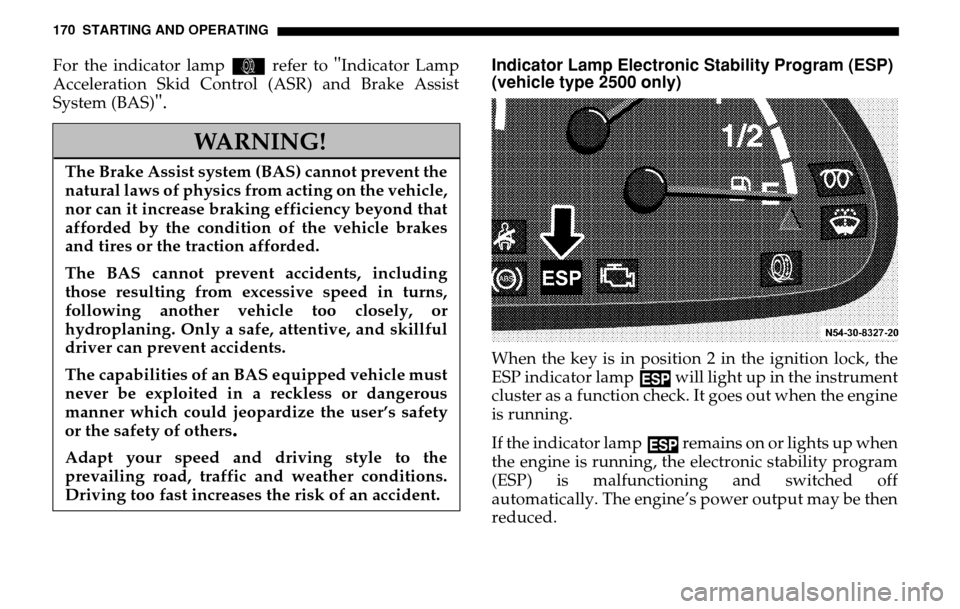
170 STARTING AND OPERATINGFor the indicator lamp k refer to
"Indicator Lamp
Acceleration Skid Control (ASR) and Brake Assist
System (BAS)
" .
Indicator Lamp Electronic Stability Program (ESP)
(vehicle type 2500 only)When the key is in position 2 in the ignition lock, the
ESP indicator lamp will light up in the instrument
cluster as a function check. It goes out when the engine
is running.
If the indicator lamp remains on or lights up when
the engine is running, the electronic stability program
(ESP) is malfunctioning and switched off
automatically. The engine’s power output may be then
reduced.
WARNING!
The Brake Assist system (BAS) cannot prevent the
natural laws of physics from acting on the vehicle,
nor can it increase braking efficiency beyond that
afforded by the condition of the vehicle brakes
and tires or the traction afforded.
The BAS cannot prevent accidents, including
those resulting from excessive speed in turns,
following another vehicle too closely, or
hydroplaning. Only a safe, attentive, and skillful
driver can prevent accidents.
The capabilities of an BAS equipped vehicle must
never be exploited in a reckless or dangerous
manner which could jeopardize the user’s safety
or the safety of others
.
Adapt your speed and driving style to the
prevailing road, traffic and weather conditions.
Driving too fast increases the risk of an accident.
Page 171 of 288

STARTING AND OPERATING 171
5
NOTE: If the ABS is malfunctioning or the voltage in
the vehicle’s electrical system drops below 10 volts, the
indicator lamp will also light up in the instrument
cluster and the ESP will be deactivated. The indicator
lamp will go out as soon as the voltage reaches this
level again or the ABS is operational again
– the ESP is
then reactivated.
Electronic Stability Program (ESP) (vehicle type
2500 only)The Electronic Stability Program (ESP) monitors the
vehicle’s traction (force of adhesive friction between
the tires and the road surface) and handling.
The ESP recognizes when a wheel is spinning or if the
vehicle starts to skid. By applying brakes to the
appropriate wheel and by limiting engine output, the
ESP works to stabilize the vehicle. The ESP is especially
useful while driving off and on wet or slippery road
surfaces.
The warning lamp v in the speedometer flashes
when the ESP is engaged, refer also to
"Warning Lamp
Acceleration Skid Control (ASR) and Electronic
Stability Program (ESP)
".
If wheels with tires of a different size than those offered
by an authorized Sprinter Dealer are used, the correct
operation of the ESP cannot be guaranteed.
WARNING!
If the ESP indicator lamp remains on, the
electronic stability program (ESP) is malfunction-
ing. The vehicle stability will no longer be auto-
matically regulated in good time.
The danger that your vehicle breaks into a skid, is
increased in certain driving situations. Drive with
extra caution.
Have the ESP repaired as soon as possible by an
authorized Spinter Dealer.
Page 172 of 288
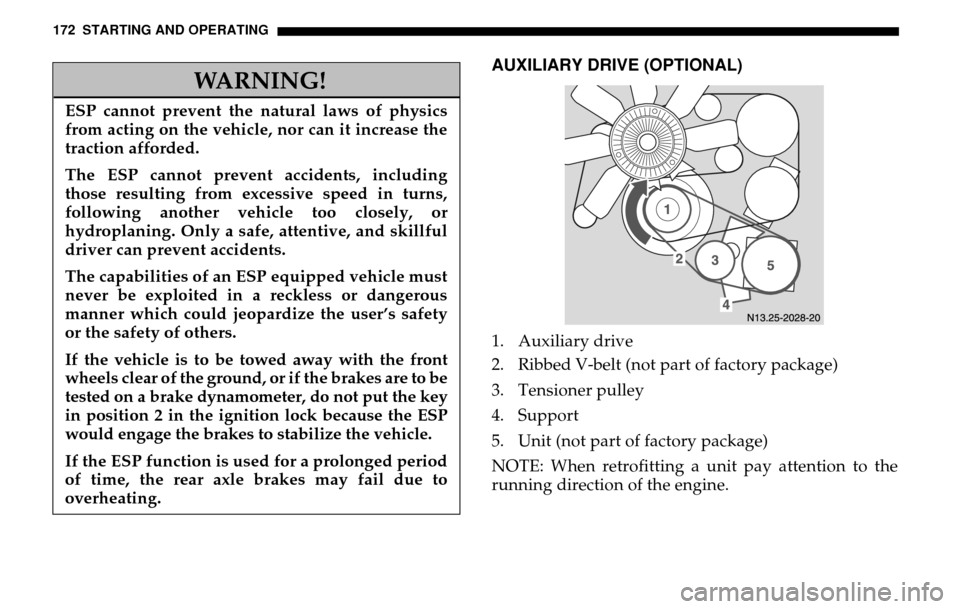
172 STARTING AND OPERATING
AUXILIARY DRIVE (OPTIONAL)1. Auxiliary drive
2. Ribbed V-belt (not part of factory package)
3. Tensioner pulley
4. Support
5. Unit (not part of factory package)
NOTE: When retrofitting a unit pay attention to the
running direction of the engine.
WARNING!
ESP cannot prevent the natural laws of physics
from acting on the vehicle, nor can it increase the
traction afforded.
The ESP cannot prevent accidents, including
those resulting from excessive speed in turns,
following another vehicle too closely, or
hydroplaning. Only a safe, attentive, and skillful
driver can prevent accidents.
The capabilities of an ESP equipped vehicle must
never be exploited in a reckless or dangerous
manner which could jeopardize the user’s safety
or the safety of others.If the vehicle is to be towed away with the front
wheels clear of the ground, or if the brakes are to be
tested on a brake dynamometer, do not put the key
in position 2 in the ignition lock because the ESP
would engage the brakes to stabilize the vehicle.If the ESP function is used for a prolonged period
of time, the rear axle brakes may fail due to
overheating.
Page 185 of 288

STARTING AND OPERATING 185
5
Open immediately the water drain screw (3) about 1 turn (counterclockwise) until fluid emerges. Ensure
that the fluid is collected in the receptacle.
Close the water drain screw (3) as soon as about 0.25 US qt (0.2 liters) are emerged.
After draining, return the key in the ignition lock to position 0.
Dispose of the collected fluid in an environmentally responsible manner.
If the filter is still saturated, drain the filter once more.
After draining, the engine may run briefly but stall for
lack of fuel. If this occurs, bleed the system.
NOTE: Should the water in the fuel indicator lamp
still not go out after the fuel filter has been drained
twice, the cause should be examined by an authorized
Sprinter Dealer.
Bleeding the Diesel Fuel SystemThe diesel fuel system must be bled before starting the
engine.
Turn the key in the ignition lock position 2 for at
least 30 seconds.
Return the key to position 0.
Start the engine three to four times. The engine control unit indicator lamp ± must go out.
NOTE: Too many attempts to start the engine could
drain the battery. If the engine does not start after
several attempts, consult an authorized Sprinter
Dealer.
Page 193 of 288

STARTING AND OPERATING 193
5
BODY BUILDER GUIDELINEIf you intend on making any alterations to the vehicle,
we strongly recommend that you select one of the
following options in order to obtain all necessary
information:
1. Contact the authorized Sprinter Dealer nearest you to obtain a copy of the Sprinter Body Builder
Guideline.
2. Call DaimlerChrysler Vans LLC at telephone (800) 992-1997 to request a copy of the Sprinter Body
Builder Guideline (there may be a charge).
3. Write to the following address and order the Sprinter Body Builder Guideline (there may be a
charge).
DaimlerChrysler Vans LLC
P. O . B o x 2 1 - 8 0 0 4
Auburn Hills, MI 48321-8004
United States of America Body Builders and Dealers who makes any
modifications which may affect the final certification of
the engine, vehicle or equipment assume the sole
responsibility for the vehicle, including labeling and
documentation, affected by their modifications.
It is their responsibility to certify that the altered
vehicle conforms to all applicable standards and
regulations affected by the vehicle alteration or
continues to comply with the Motor Vehicle Safety
standards and Emissions regulations.
WARNING!
Any modifications or alterations of the Sprinter
vehicle not in compliance with the Sprinter Body
Builder Guideline and the Sprinter Operator’s
Manual may seriously inhibit its roadworthiness
and safety and may lead to an accident resulting in
serious personal injury or death. Consult the
Sprinter Body Builder Guideline and the Sprinter
Operator’s Manual prior to initiating any alter-
ations or modifications.
Page 194 of 288

194 STARTING AND OPERATINGThey are responsible for ensuring that modifications or
equipment installation does not affect the safety of the
vehicle.A Special Note Concerning Vehicle Alteration
The Manufacturer is not responsible for any final
certification or claims sounding in product liability, or
warranty claims, which result from any component,
assembly, or system being altered, or which cause non-
compliance with any of the emission control standards
or motor vehicle safety standards, or which would
otherwise cause the vehicle to be or become defective
or unsafe.
The Manufacturer does not assume the responsibility
as the final stage manufacturer or the consequential
product liability.
WARNING!
Any modifications or alterations of the Sprinter
vehicle not in compliance with the Sprinter Body
Builder Guideline and the Sprinter Operator’s
Manual may seriously inhibit its roadworthiness
and safety and may lead to an accident resulting in
serious personal injury or death. Consult the
Sprinter Body Builder Guideline and the Sprinter
Operator’s Manual prior to initiating any alter-
ations or modifications.
Page 211 of 288
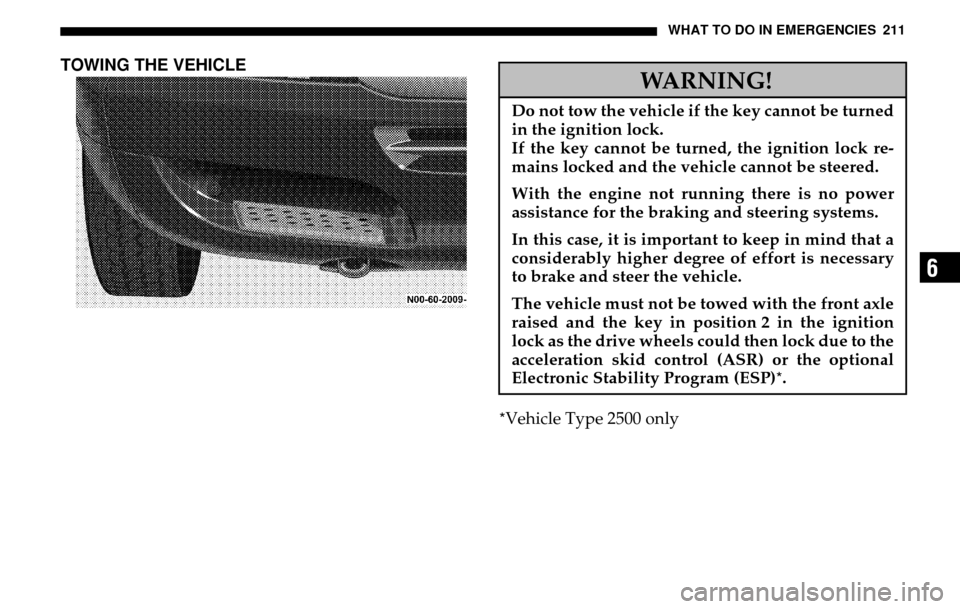
WHAT TO DO IN EMERGENCIES 211
6
TOWING THE VEHICLE
*Vehicle Type 2500 only
WARNING!
Do not tow the vehicle if the key cannot be turned
in the ignition lock.
If the key cannot be turned, the ignition lock re-
mains locked and the vehicle cannot be steered.
With the engine not running there is no power
assistance for the braking and steering systems.
In this case, it is important to keep in mind that a
considerably higher degree of effort is necessary
to brake and steer the vehicle.
The vehicle must not be towed with the front axle
raised and the key in position 2 in the ignition
lock as the drive wheels could then lock due to the
acceleration skid control (ASR) or the optional
Electronic Stability Program (ESP)
*.
Page 218 of 288

218 MAINTAINING YOUR VEHICLEDisposal of Service ProductsDispose of service products and of parts which come
into contact with them (e.g. filters) in an
environmentally responsible manner. Comply with
applicable bars and regulations.EMISSION RELATED COMPONENT WARRANTY
STATEMENTThe Manufacturer warrants to the original and each
subsequent owner of a Sprinter heavy-duty on
highway diesel engine that:
(1) the engine was designed, built and equipped so as
to conform at the time of sale with the applicable
regulations adopted by the Federal Environmental
Protection Agency, and
(2) the emission control system of such engine is free
from defects in materials and workmanship which
would cause it not to conform with those regulations
for a period of use of five years or 100 000 miles or
3 000 hours of engine operation, whichever occurs
first.
REGULAR CHECKSThe following checks should be performed at regular
intervals (for example once a week or each time the
vehicle is refueled):
Windshield cleaner system – fluid reservoir.
Air strainer, in vehicles with an air strainer element maintenance indicator (optional equipment).
Engine oil level.
Checking ribbed V-belt.
Hydraulic brake system, clutch mechanism fluid level.
Coolant level.
Tire and spare wheel condition and pressures of the same. For more information, refer to "Wheels and
Tires".
Vehicle lighting.
Page 224 of 288
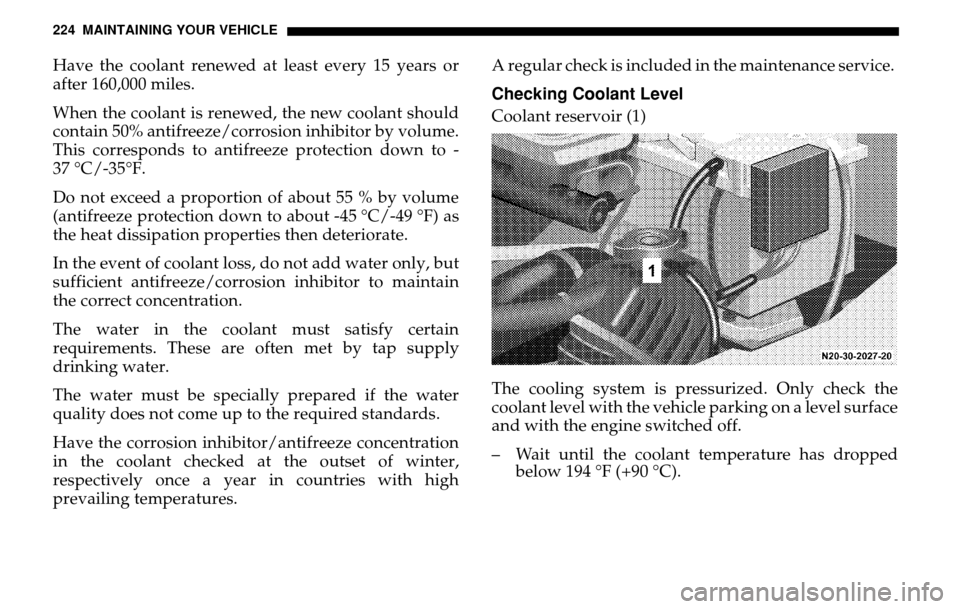
224 MAINTAINING YOUR VEHICLEHave the coolant renewed at least every 15 years or
after 160,000 miles.
When the coolant is renewed, the new coolant should
contain 50% antifreeze/corrosion inhibitor by volume.
This corresponds to antifreeze protection down to -
37 °C/-35°F.
Do not exceed a proportion of about 55 % by volume
(antifreeze protection down to about -45 °C/-49 °F) as
the heat dissipation properties then deteriorate.
In the event of coolant loss, do not add water only, but
sufficient antifreeze/corrosion inhibitor to maintain
the correct concentration.
The water in the coolant must satisfy certain
requirements. These are often met by tap supply
drinking water.
The water must be specially prepared if the water
quality does not come up to the required standards.
Have the corrosion inhibitor/antifreeze concentration
in the coolant checked at the outset of winter,
respectively once a year in countries with high
prevailing temperatures. A regular check is included in the maintenance service.
Checking Coolant LevelCoolant reservoir (1)
The cooling system is pressurized. Only check the
coolant level with the vehicle parking on a level surface
and with the engine switched off.
– Wait until the coolant temperature has dropped
below 194 °F (+90 °C).
Page 228 of 288
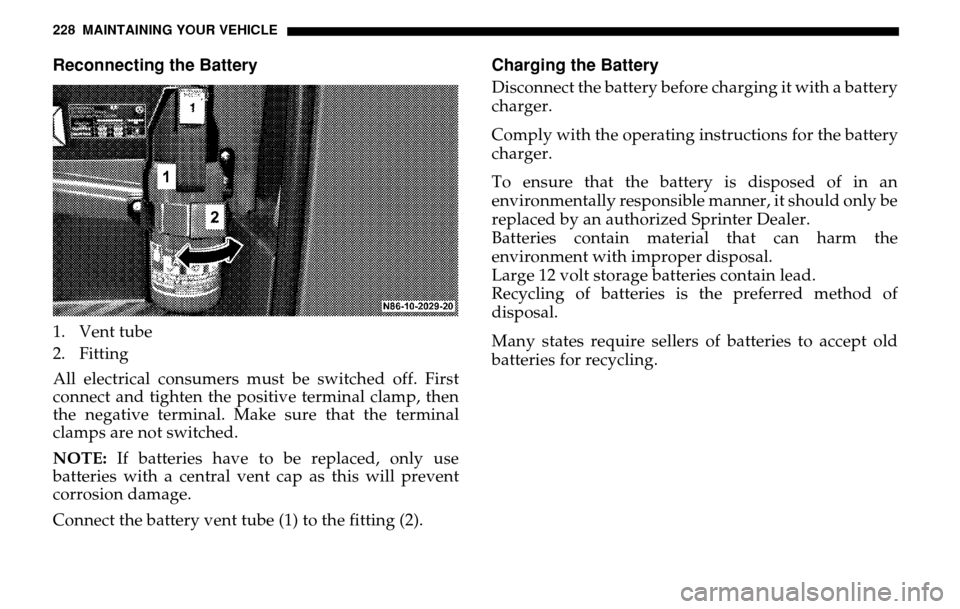
228 MAINTAINING YOUR VEHICLEReconnecting the Battery1. Vent tube
2. Fitting
All electrical consumers must be switched off. First
connect and tighten the posi tive terminal clamp, then
the negative terminal. Make sure that the terminal
clamps are not switched.
NOTE: If batteries have to be replaced, only use
batteries with a central vent cap as this will prevent
corrosion damage.
Connect the battery vent tube (1) to the fitting (2).
Charging the BatteryDisconnect the battery before charging it with a battery
charger.
Comply with the operating instructions for the battery
charger.
To ensure that the battery is disposed of in an
environmentally responsible manner, it should only be
replaced by an authorized Sprinter Dealer.
Batteries contain material that can harm the
environment with improper disposal.
Large 12 volt storage batteries contain lead.
Recycling of batteries is the preferred method of
disposal.
Many states require sellers of batteries to accept old
batteries for recycling.